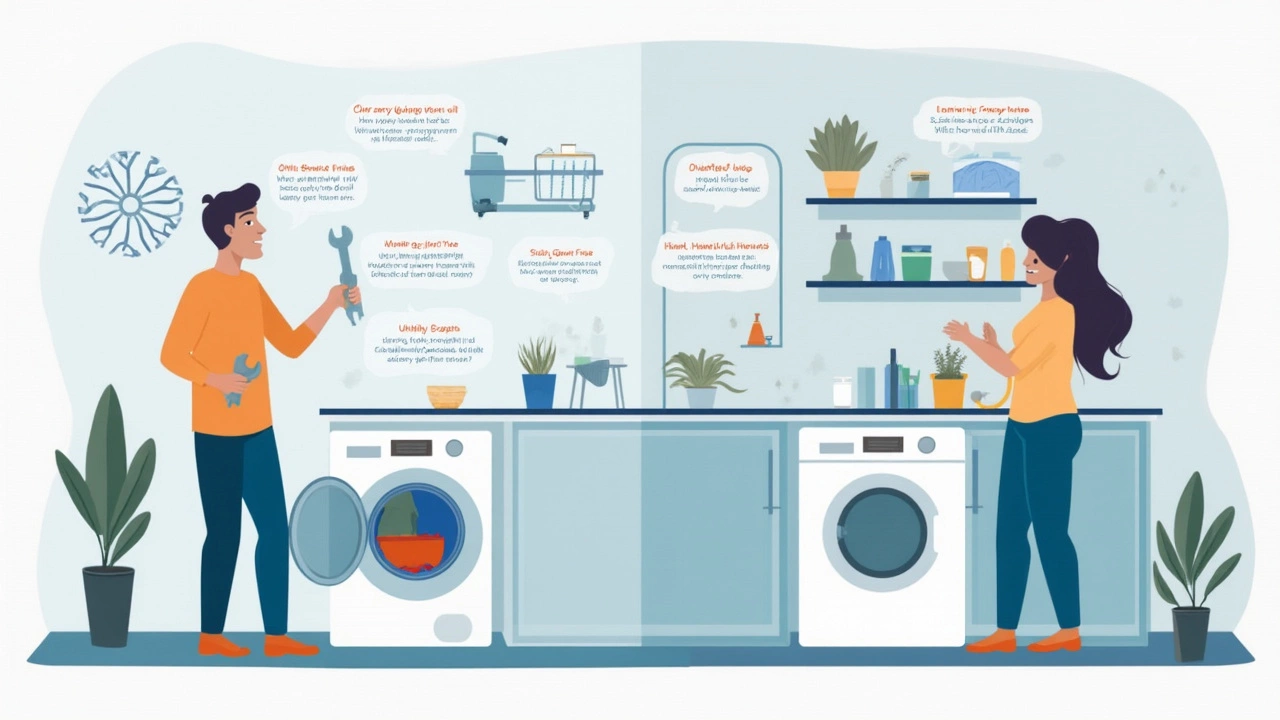If your washing machine is 7 years old and just started acting up, you’re not alone. Most washers start showing their age right about now, so it’s natural to pause before spending money on a repair. Parts wear out, new noises appear, and the spin cycle isn’t what it used to be. But does fixing it make sense, or are you throwing good money after bad?
Let’s get straight to what matters. Seven years isn’t the end of the road for every washing machine, but it’s well past that shiny-new phase. While some machines soldier on for a decade or more, others already have one foot in the appliance graveyard. The real trick is figuring out where your washer stands, how much a fix will likely cost, and if you’ll get enough years out of it to justify the repair bill.
I’ve run into this situation myself—coming home to a wet pile of laundry and a washer that sounds like it’s grinding gravel. The first instinct is to hope it’s just a loose hose. Sometimes, you get lucky. Other times, the repair quote makes you wonder if it’s time to pick out a new washer, one with all those smart features you never thought you’d want.
- Understanding Washer Lifespan
- Common Problems After 7 Years
- Crunching the Numbers: Repair vs Replacement
- When Repairs Make Sense (and When They Don’t)
- Smart Tips Before You Decide
Understanding Washer Lifespan
The big question is, how long are washing machines really meant to last? For most folks, the average lifespan falls somewhere between 8 to 12 years, depending on the brand and how much use it gets. So if your machine is 7 years old, it’s often right in that grey zone—neither brand new nor truly ancient.
Top-loader models typically hang around a little longer than front-loaders, mostly because they’re built simpler and with fewer things that can go wrong. Still, how you use and take care of your washer has a huge impact. A machine that runs almost every day and rarely gets a clean-out will likely throw in the towel earlier than one used just for the basics and cleaned out regularly.
Here’s a quick look at what affects your washer’s lifespan the most:
- washing machine repair history—repeat repairs are a red flag
- Load size—overloading stresses out the motor and drum
- Water quality—hard water can wear down parts faster
- Maintenance—keeping filters and hoses clear really does matter
- Brand reputation—some brands are just more reliable over the long haul
Check out these numbers from a 2023 home appliances survey:
| Type of Washer | Median Lifespan (years) |
|---|---|
| Top-Loader | 11 |
| Front-Loader | 9 |
So, if your 7-year-old machine has worked hard, skipped maintenance, and is on repair number three, it’s probably getting close to retirement. But one that’s lightly used and never broken down might have plenty of washes left.
Common Problems After 7 Years
At the 7-year mark, your washer’s weak points start to show. The stuff you barely noticed before—like longer cycles or puddles on the floor—can get worse fast. I’ll cut right to the fixtures that trip most folks up.
- Washing machine repair calls usually spike because of worn belts or broken pumps. These parts just don’t last forever, especially with heavy loads.
- Leaky hoses and door seals are infamous around this age. You spot water underneath after a cycle, and it’s often these cheap bits giving up.
- Agitator problems or a drum that won’t spin right can mean motor or bearing issues. This isn’t a quick fix, and parts aren’t always in stock for older models.
- Control panel glitches creep in. Washers today have more electronics, which means things like dead buttons or blinking lights get more common—not just with old machines, but especially after 7 years.
- Drainage problems show up, too—clogged filters, broken pumps, or hoses stuffed with lint. Ignoring these seems tempting but leads to bigger headaches fast.
A quick peek at what pros see most after 7 years might help put things in perspective:
| Problem | Chance You’ll See It |
|---|---|
| Leaky hose/seal | High |
| Failed pump | Medium |
| Drum or bearing noise | Medium |
| Control board issues | Low to medium |
| Motor failure | Low |
If you hear grinding or banging during the spin, it’s time for a checkup. Musty smells you can’t get rid of, half-wet loads, or error codes showing up are all signals the machine’s getting tired. Fixes can be simple and cheap, or pricey and frustrating, depending on what’s acting up. That’s why it helps to know the main suspects before calling in a pro.

Crunching the Numbers: Repair vs Replacement
This is where things get real. Out of all the calls I’ve made to appliance repair shops, one thing always stands out—the numbers can make or break your decision. Most folks don’t realize that a washing machine repair isn’t always the best move for older machines. At seven years old, your washer is out of warranty, and some repair jobs can cost almost as much as a replacement.
The general rule in the repair world is pretty clear: if the repair costs more than 50% of what a comparable new washer would cost, it’s probably not worth it. How does that play out today? Here’s a snapshot:
| Average Cost | Details |
|---|---|
| $150 - $400 | Typical repair (pump, belt, minor electrical parts) |
| $500+ | Major repairs (motor, transmission, control board) |
| $600 - $1000+ | New mid-range washing machine |
Let’s put that in perspective. If you’re hit with a bill for a new motor or control board, you might be halfway to buying a new machine. Those mid-range replacements have better efficiency and can save you cash on utilities—something your seven-year-old model may not be good at.
- Add in hidden costs like delivery or installation for new washers, which usually run another $50 to $150.
- Factor in appliance disposal fees, about $30 to $75 if you can’t haul it away yourself.
- Don’t forget that a new washer likely comes with at least a one-year warranty, kicking repairs down the road for a while.
At this age, small repairs make the most sense, especially if the rest of the machine has been running pretty smoothly. But if you’re racking up repair bills every year, it quickly adds up. It’s like that old car you keep fixing—eventually, you’re better off with something more reliable.
When Repairs Make Sense (and When They Don’t)
There's a sweet spot where repairing a 7-year-old washing machine actually makes sense, but the window can close fast. The first thing to look at is what’s broken and how much it’ll cost. If it’s something simple, like a belt, hose, or even a door latch—good news. These fixes are usually quick and relatively cheap. On average, a straightforward repair falls between $100 and $250. If you’re not dealing with leaks, electrical problems, or major motor issues, this could buy your washer another couple of years.
But here's where it gets tricky. When big parts start to go—like the drum, transmission, or control board—the costs shoot up. Replacing a drum can run over $400, which isn’t a smart move on an older machine. That's when it feels like you’re patching up a car with 200,000 miles. If the estimate is more than half the price of a new mid-range washer (~$500 to $700), it’s almost always better to cut your losses and upgrade.
Warranty matters, too. If your manufacturer or extended warranty still covers the repair, don’t hesitate—get it fixed. But for most 7-year-old models, that ship has sailed. Double check anyway; some brands like LG and Samsung offer longer coverage for certain parts.
- Repair makes sense if the fix is under $250, the machine hasn’t had repeated issues, and it’s not leaking everywhere.
- Replace if costs are stacking up, big components are shot, or it’s your second major repair in a year. That’s a clear sign the rest of the parts are probably on their way out, too.
What really surprises people is how quickly small repairs can add up if your washer is just starting to wear down. If you’re calling out a repair tech twice a year, those bills will pile up—and fast. Worse, you might miss out on newer models that are more energy efficient, which save money long-term.
| Issue | Average Repair Cost | Worth Fixing? |
|---|---|---|
| Belt/Hose | $75 – $180 | Yes |
| Drain Pump | $150 – $300 | Maybe |
| Drum/Motor | $350 – $500+ | No |
The truth is, fixing old washers can be smart—up to a point. Weigh the repair cost against what you’d pay for a new one, and don’t forget to factor in peace of mind. You don’t want to spend Sunday fighting with a machine that’s clearly seen better days. When in doubt, use this rule: if repairing your washing machine costs more than half the price of a decent new model, it’s probably time to move on.

Smart Tips Before You Decide
Never rush straight to repairing a 7 year old washer. There are a few things you want to check off before you even call a tech—and they can save you time, stress, and money.
- Know your washer's repair history. If this is the first time it’s malfunctioned, there’s a good chance the fix could last a while. If it’s been a money pit lately, that won’t change.
- Check your owner’s manual or search the model online for any recalls or extended warranties. Some parts might actually be covered even if the standard warranty ended—manufacturers sometimes offer hidden extended coverage for known issues.
- Get a clear repair quote before approving work. For a 7 year old model, the general suggestion is: if repairs cost more than 50% of the price of a new machine, pass. Those dollars are better spent on a new appliance with fresh parts and better energy efficiency.
- Compare the features you’d gain with a new washer—like quicker cycles or lower water use—to what you might lose in the hassle of researching and buying new. If you’ve always wanted more settings or a quieter spin, now’s your moment.
- Take stock of parts availability. Some brands stop making replacement parts after about 7-10 years, so if your model is obscure or discontinued, even a small fix can become a wild goose chase for the right components.
- If the washer has visible rust on the drum, cracks in the outer shell, or water leaks that can’t be traced to a hose or gasket, these are dealbreakers for repair. These problems just aren’t worth solving at this age.
Want something concrete? Here’s a simple table breaking down typical repair costs compared to a basic new machine (as of 2024):
| Common Repair | Average Cost (USD) | New Basic Washer | Cost (USD) |
|---|---|---|---|
| Drain pump | $120 - $250 | Top-loader | $500 - $700 |
| Control board | $200 - $350 | Front-loader | $800 - $1200 |
| Bearing/seal | $350 - $600 | Energy Star model | $850 - $1400 |
Don’t forget to factor in your own time. Shopping, delivery, and hauling off an old washer take real effort—and sometimes it’s worth paying a little more for less hassle. Bottom line: don’t let nostalgia or the fear of a repair bill cloud your decision. Trust the math, trust the facts, and trust your gut. If the repair looks borderline, think long-term. Sometimes, biting the bullet for a new appliance saves you more headaches (and cash) down the line.


